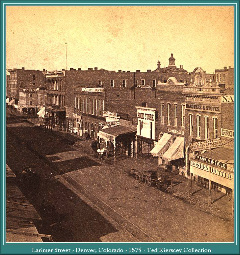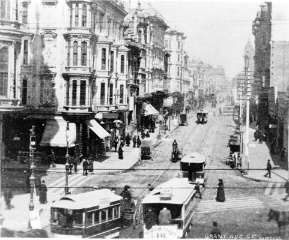When I was scouting around for a place to set the Devon Day and the Sweetwater Kid stories, I checked out several cities that would have fit their bill back in the 1870’s. I wanted something west of the Mississippi, of course, and there weren’t many large cities in that area.
 Denver, Colorado was one option. The Denver Pacific railway line would have been in place, and the city was a major stopping point for travelers. I decided the lads would have spent time here, especially between “jobs,” but would have eventually settled on an even larger city as their permanent base of operations.
Denver, Colorado was one option. The Denver Pacific railway line would have been in place, and the city was a major stopping point for travelers. I decided the lads would have spent time here, especially between “jobs,” but would have eventually settled on an even larger city as their permanent base of operations.
San Francisco in the 1870’s rivaled New York City. Around 150,000 people called the city home, and Kye and Chance would have been able to blend right in. Plus, San Francisco was a modern wonder, with paved streets, gaslights, an excellent public transport system, and even skyscrapers.
It wasn’t too hard to pick the lads’ home city once I started looking at old photographs. They’d have gone for the bright lights and 24-hour entertainment.
Setting is another area where beginning writers have trouble. They may not fully understand the concept, or they might not have completely thought out their particular setting.
Setting is not only the place in which the story occurs, but also the time and social environment. A story can take place in New York City, for example, but the reader also needs to know when it’s happening (present day? the 1890’s? prehistoric times?) and which social setting the characters must deal with (high society? desolate poverty? middle class?).
In order for your readers to identify fully with the story, your setting must be both clear and vivid. The reader must understand where and when the story is taking place, and must form a memorable mental image of that setting.
Here are some tips for crafting your setting:
- Use all of the senses – Don’t just show the readers where they are. Let them smell and hear it, and they’ll remember it better.
- Make the setting a character – Create a setting that is unique to your story, such that the action simply couldn’t take place anywhere (or anywhen) else.
- Know the setting intimately – Find or create a map and post it onto your cork board. Choose photographs to inspire you (these can be actual pictures of the setting, or just something that reminds you of your imaginary world). You should know the setting well enough to give a stranger directions. You may never use all of your knowledge, but just having it in your mind will create a more vivid experience for your readers.
You’ve all heard it: use the five senses to describe your world. However, it’s not enough just to jot down a quick list of sight, sound, smell, feeling, and maybe even taste.
Here are some tips to really make your writing “pop” with sensory detail.
Sight – Don’t just monologue about what the character is seeing. Pick a couple of details that show your readers something they won’t forget. Choose something specific that makes your setting unique.
- The moon-path glittered before me on the lake, and I wanted to follow it to a better world.
- She watched the orange ball sink behind the white stone face of her mountain.
- Mirrored walls cast rainbowed shadows on the sidewalk.
Sound – Use sounds to move your action along and add depth to a scene. But, as I read in a recent writing article, for goodness’ sake, be creative with your onomatopoeia!
- She had to yell her reply over the chuffing of the helicopter rotors.
- He dozed in the hammock to the buzz of hummingbird wings.
- The pock, pock of the horse’s hooves echoed from the canyon.
Smell – Don’t just go for the obvious. Pick something that doesn’t immediately evoke the idea of scent, and create a memorable detail for your reader. Pay attention to scene changes, too, because the new setting probably smells different.
- The sharp, copper tang of overheated electrical wires made the hairs on the back of my neck stand straight up.
- He held back a sneeze as she drew near. She must have bathed in Chanel No. 5.
- The sky was black and purple, and the scent of the storm lifted her mood.
Touch – Again, avoid the obvious. Your entire body is covered with sensory organs, so your characters should feel many things besides what their hands are touching.
- The wind cut through his thin jacket like a thousand needles.
- Sweat prickled and puddled at her hips.
- I leaned against the cold stone of the bank and wondered where I could find the money.
Taste – Yes, this is more difficult to work into a story. You can’t always have your characters eating things, or licking them to see how they taste. However, there are ways to use this sense to give your readers that unforgettable sense of your universe. Remember that it doesn’t have to be food to be tasted – and it doesn’t even have to be a literal taste at all.
- The acrid smoke left a bitter taste at the back of my throat, and I coughed and sputtered.
- She let the bourbon evaporate in her mouth, leaving only the stinging aftertaste.
- He remembered the melancholy taste of Fall in New England.
What is the most memorable detail you’ve ever read?
Setting is the time, place, and social environment for your story. Amateur writers generally ignore setting, except as a stage backdrop. Here are some tips on creating a memorable setting.
Setting must be a character in itself, not just a picture painted at the back of your stage.
- Make it familiar: choose a setting that you know, inside and out. This doesn’t always mean picking somewhere you’ve actually been, although in many cases, that is the best way to create a memorable setting. It does mean, however, that you need to do your homework. Buy maps of the city and study Google Earth to learn how your characters will get around and where they will live. Read travel articles. Study photographs. If you have created this location (as in science fiction, fantasy, or alternate world stories), create the maps as well. You should be able to tell a reader how to get from Point A to Point B as if you were a resident.
- Make it integral: don’t just plop your characters down in a convenient location somewhere. Choose a setting that will resonate with them, and with the story. Make it a city that will interfere with their goals or desires, or a country setting that provides natural tension or conflict. Pick a place that generates emotion. Create the only place that your story can take place.
- Make it memorable: you don’t have to spend paragraphs describing your setting. Add details that will stand out in your readers’ minds. Remember to utilize all of the senses, as well. Give your readers the sounds and smells and tastes of your city or town. Make it real with the little details that they’d get if they actually visited.
What is the most memorable setting you’ve read about?



